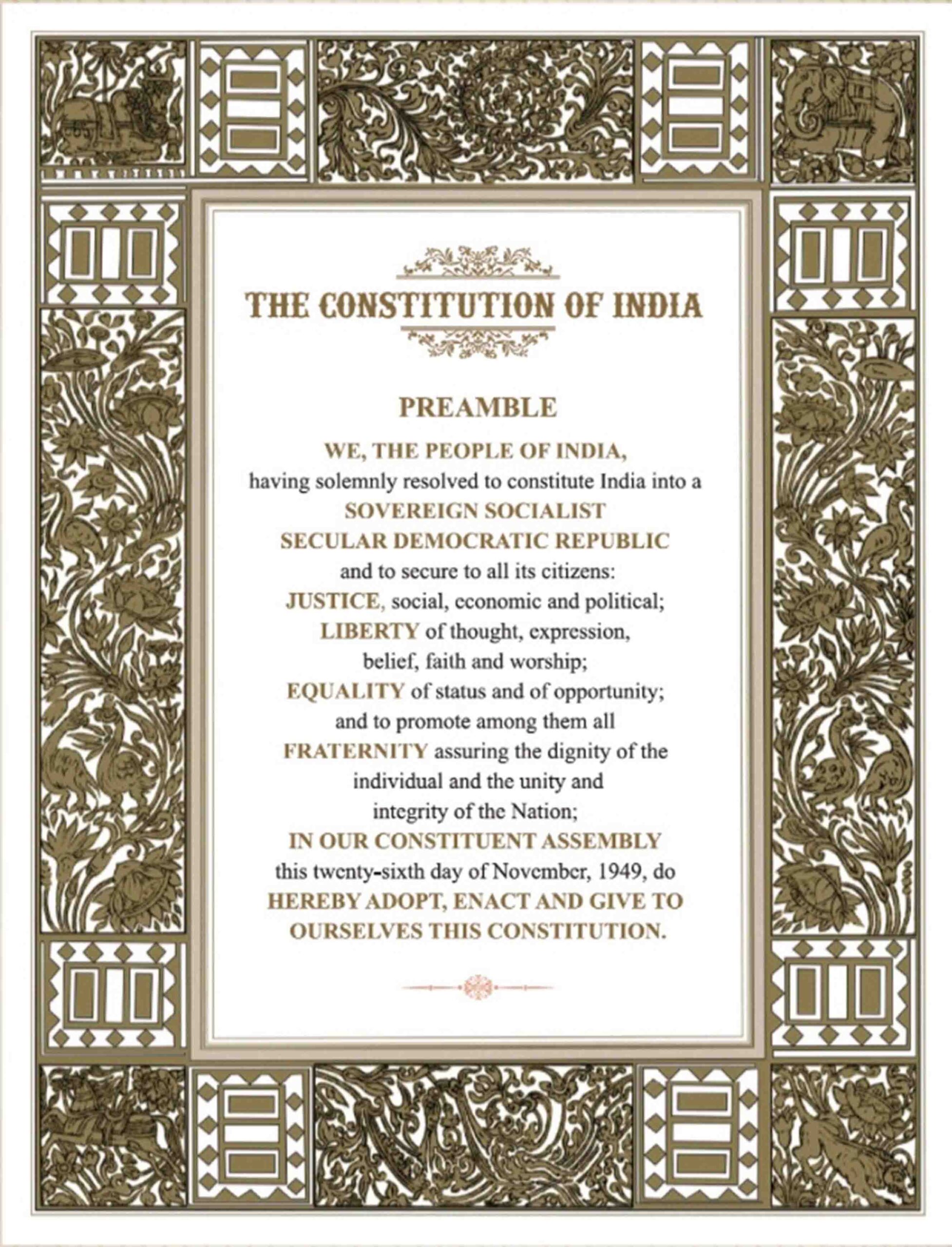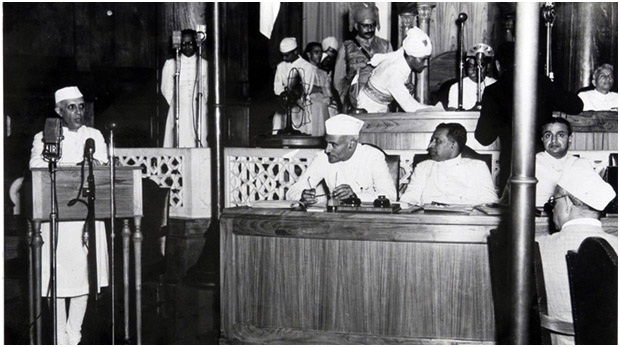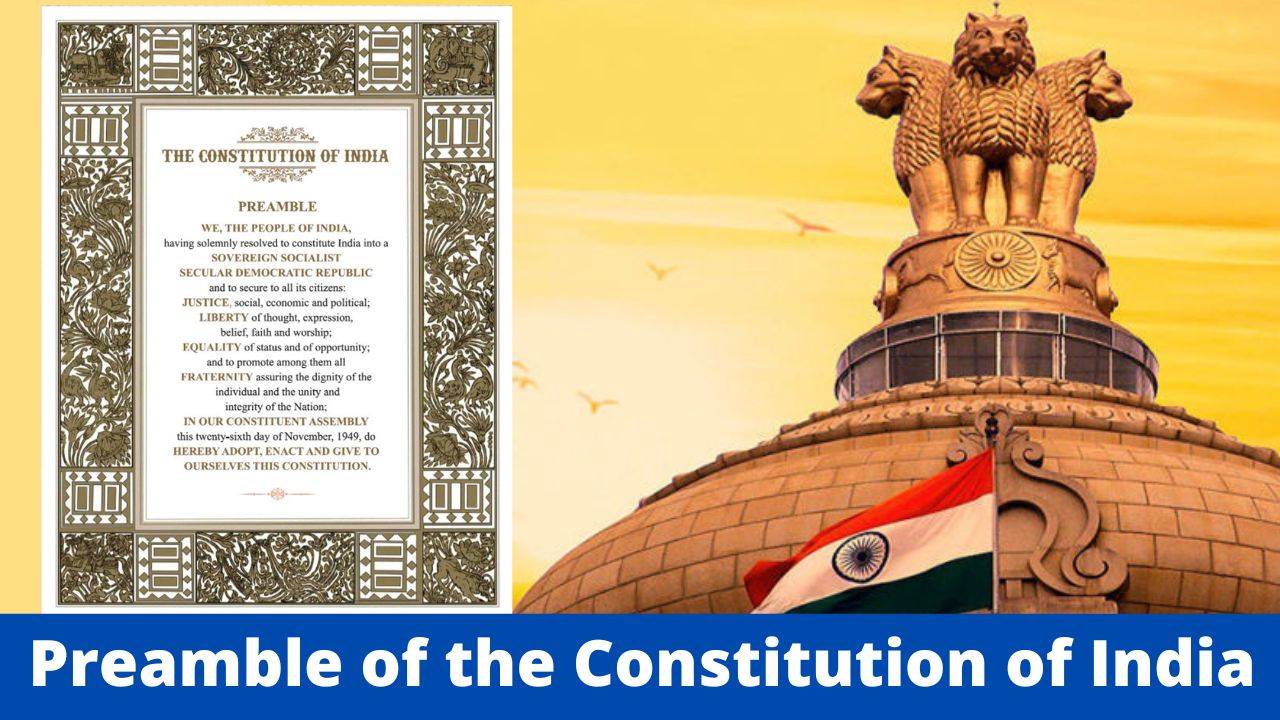Table of Contents
What is Preamble?
A Preamble is an introduction to a certain document. A preamble leads to the introductory part of a certain document which speaks about the content motive and purpose of the document. Before the term preamble came about, the Greeks used the word ‘prologue’ to refer to such introductory statements. The term ‘prologue’ still refers to introductory sections of books and plays, while ‘preamble’ is most commonly associated with legal documents and charters.
According to Webster’s Dictionary, a preamble is the introductory part of a constitution or statute that usually states the reasons for and intent of the law. Curtain-raiser, overture, preliminary, prelude, prologue, warm-up, etc are some of the synonyms of the preamble.
According to the Cambridge English dictionary, the preamble is an introduction to a speech or piece of writing.
According to the Legal Dictionary, a preamble refer to an introductory statement that in turn describes or states the reason for, the remaining portion of the document or writing. Preambles are, however, used at the beginning of other documents, such as charters, constitutions, and legal documents.
According to Wikipedia, a preamble is an introductory and expressionary statement in a document that explains the document’s purpose and underlying philosophy. When applied to the opening paragraphs of a statute, it may recite historical facts pertinent to the subject of the statute. It is distinct from the long title or enacting formula of a law.

Why preamble is an important?
The preamble clearly communicates the intentions of the framers and the purpose of the document. The preamble is not the law. It does not define government powers or individual rights. The philosophy on which the entire Constitution has been built is contained in the Preamble. It provides a standard to examine and evaluates any law and action of the government to find out whether it is good or bad. Hence, it is the soul of the Constitution.
The preamble of the Indian Constitution:
Text Of The Preamble
WE, THE PEOPLE OF INDIA,
having solemnly resolved to constitute India into a
SOVEREIGN, SOCIALIST, SECULAR, DEMOCRATIC, REPUBLIC
and to secure to all of its citizens;
JUSTICE social, economic and political;
LIBERTY of thought, expression, belief, faith and worship;
EQUALITY of status and of opportunity; and to promote among them all;
FRATERNITY assuring the dignity of the individual and the unity and
integrity of the nation;
IN OUR CONSTITUENT ASSEMBLY,
this 26th day of November, 1949, do
HEREBY ADOPT, ENACT AND GIVE TO
OURSELVES THIS CONSTITUTION.
The preamble to the Indian constitution speaks about the basic philosophy contained in the body of the Indian Constitution. While our constitution was being drafted, Pt. Jawahar Lal Nehru presented a draft of expectations of the constitution in front of the constituent assembly, mentioning the rights and liberties and ideas and expressions behind the constitution. The draft presented on 13th December, 1946, known as the ‘objective resolution’, was adopted as a preamble on 22nd January, 1947.
Historical event of the adoption of the Preamble:
According to the Resolution, the Constituent Assembly would first proclaim India as the Independent Sovereign Republic, with all territories remaining autonomous and possessing residuary powers; all Indians would be guaranteed justice, equality of status, freedom of thought, expression, belief, faith, worship, vocation, association, and subject to the law and public morality; and adequate safeguards would be provided for minorities, backward, and depressed people.

Late in the evening of 14 August, 1947 the Assembly met in the Constitution Hall and at the stroke of midnight, took over as the Legislative Assembly of an Independent India.
On 29 August, 1947, the Constituent Assembly set up a Drafting Committee under the Chairmanship of Dr. B.R. Ambedkar to prepare a Draft Constitution for India. While deliberating upon the draft Constitution, the Assembly moved, discussed, and disposed of as many as 2,473 amendments out of a total of 7,635 tabled. The member adopted the Constitution of India on 26 November, 1949 and they appended their sign to ot on 24 January, 1950.

Why did the constituent Assembly adopt the objective resolution?
The major reason behind the adoption of these resolutions in form of the preamble was, that these resolutions encompassed the clear thoughts of the constitution makers. It contained very explicitly, that what kind of India is required after the independence, therefore the Constituent assemble after some slight changes, adopted these resolutions as the Preamble of the World’s biggest Constitution. The President of the Constituent Assembly, Dr. Rajendra Prasad told the assembly, that they must adopt this resolution without any second thought. And asked all the members to vote for it, to adopt the things said and written in the resolution. The resolution was thus adopted with the complete majority.
Again, on 17th October, 1949, the Constituent Assembly thought to discuss the preamble. A member of the assembly, Hasrat Mohani suggested that instead of “a Sovereign Democratic Republic”, it must be made, “a Union of India Socialist Republics”. This was objected to by another member saying that doing so would be an antithesis to the very constitution they had passed.
Nature And Objective Of The Preamble:
“We, the people of India”:
It is the resolve of the people of India to constitute India into a Sovereign, Democratic, Republic. From the Preamble of the Constitution, it is clear that the framers attached importance to the sovereignty of the people. The words sovereign, socialist, secular, democratic, and republic, define the nature of the constitution whereas the words justice, equity, liberty, and fraternity establish the objective of the Indian constitution.
Sovereignty:
‘Sovereignty’ is one of the foremost elements of any independent State. It means that India is an independent country and no external power should interfere in the internal matters of the country. Hence, India is a sovereign country. It is free from external control. India is free to formulate its own foreign policy. “Sovereignty” is therefore a term of art rather than a legal expression capable of a precise definition.
Socialist:
In 1976, the 42nd Amendment to the Constitution incorporated ‘Socialist’ and ‘Secular’, in the Preamble. The word ‘Socialism’ had been used in the context of economic planning. It signifies a major role in the economy. The socialism in the preamble is derived from Mahatma Gandhi’s and Jawahar Lal Nehru’s philosophy which has the primary objective of establishing a welfare state, i.e. to eliminate poverty, ignorance, inequality, and discrimination in society. In the Directive Principles of the State Policy, these ideals have been incorporated as well as partly, implemented in the Constitution.
Secular:
Secularism in India, it is said that ‘India is neither religious nor irreligious nor anti-religious.’ It implies that in India there will be no ‘State’ religion – the ‘State’ will not support any particular religion out of the public funds.
India has used secularism with a positive connotation, meaning thereby that although the state won’t have any religion of its own the people of India can freely practice, propagate and profess any religion of their choice.
This has two implications-
(a). every individual is free to believe in, and practice, any religion he/ she belongs to, and,
(b). The state will not discriminate against any individual or group on the basis of religion.
In many countries, the word ‘secular’ is interpreted as being anti-religion. For instance, in countries like France, practicing religion publicly is not allowed. Articles 25 to 28 of the Indian Constitution guarantee every person the freedom of conscience and the right to profess, practice, and propagate religion.
In S.R. Bommai v. Union of India,(1994) SCC 1, the supreme court held that “secularism is the basic feature of the Constitution”
Democratic:
The term democracy is derived from the Greek word ‘Demo’ which means the people and ‘Kratos’ which means authority. Democracy means government by the people. The Preamble also declares India as a Republic. It means that the head of the State is the President who is indirectly elected and he is not a hereditary ruler as in the case of the British Monarch.
The last line of the Preamble says “…. hereby adopt, enact and give to ourselves this Constitution”. In fact, the democratic principles of the country flow from the last line of the Preamble. Democracy is generally known as a government of the people, by the people, and for the people.
In Mohan Lal v. District Magistrate, Rai Bareilly:
The court defined democracy as the political concept in which the people directly or through their representatives give their involvement in the administration.
In Union of India v. Association for Democratic Reforms:
The court observed that democracy is an important essential of a welfare state, the people should get a chance to elect a leader who can act for the people.
Republic:
The term ‘Republic’ implies ‘an elected Head of the State’. A democratic State may have an elected or a hereditary head. The British monarch, a hereditary ruler, is no hindrance to the latter type. The concept of a Republic means the people of the state have the supreme power and they transfer their power to their representative by appointing him as the head of the state. It is completely different from the concept of monarchy, in monarchy the king, the queen then their child become the head of the state i.e. hereditary is being followed, but in the concept of a republic, the state is headed by the head of the state elected by the citizen.
Justice:
Justice promises to ensure that people receive what they are entitled to in terms of basic rights, such as food, clothing, housing, participation in decision-making, and the ability to live with dignity as human beings. The essence of justice is the attainment of the common good. It embraces, as the Preamble proclaims, the entire social, economic, and political spheres of human activity.
In Air India Statutory Corporation v. United Labour Union:
The court observed that the aim of justice is to secure the political, social, economic interests of the citizen and provide the with opportunity and a standard of life and allow them to live with dignity.
Liberty:
Liberty means Freedom. The term Liberty was included to secure the freedom of the people of their beliefs, thoughts, faith, etc. The term Liberty is used in the ‘Preamble’ It signifies not only the absence of any arbitrary restraint on the freedom of individual actions but also the creation of conditions that provide the essential ingredients necessary for the fullest development of the personality of the individual.
In Govt of A.P. and others vs. P. Laxmi Devi2008 (4) SCC 720, JT 2008 (2) 639 and Deepak Bajaj vs. the State of Maharashtra and others, JT 2008 (11) SC 609. In these cases, the Supreme Court has emphasized the importance of liberty for progress and has observed that the judiciary must act as guardians of the liberties of the people, protecting them against the executive, or even legislative arbitrariness or despotism. Liberty, Equality, and Fraternity are not to be treated as separate entities but as a trinity. They form a union in that and to divorce one from the other is to defeat the very purpose of Democracy.
Equality:
Equality does not mean that all human beings are equal mentally and physically. On the other hand, it signifies equality of status, and equality of opportunity. The equality of status is provided by the prohibition of artificial restriction on the ground of religion, race, caste, color, place of residence, etc. It is supplemented by the prohibition of untouchability and by the abolition of titles. At the same time, equality of opportunity is provided by the guarantee of rule of law signifying equality before the law and non-discrimination in matters of public employment.
Fraternity:
The concept of the fraternity was introduced so that people feel that all people of the same soil, the same motherland are their brothers and sisters and are equal in status. India is a country having diversity based on religion, race, and caste so it is important to promote the spirit of brotherhood among them all.
Landmark Cases on Preamble:
1. Kesavananda Bharti v State of Kerala ( AIR 1973 SC 1461):
It was decided by a Bench of thirteen judges (the largest Constitution bench). It has created history. For the first time, a bench of 13 Judges assembled and sat in its original jurisdiction to hear the writ petition. 13 Judges placed on record 11 separate opinions.
This case too discussed restricting the government’s interference in citizens’ Right to property. During 1971-72, some Constitutional amendments took place as a result of which two Kerala Act on Land reform is added in the 9th Schedule. Those amendments were challenged in this case.
(a). SC said that Parliament can amend the whole Constitution including fundamental rights.
(b). But the basic structure of the Constitution cannot be amended.
(c). Basic structure was defined & specified in this case. E.g. Judicial Review.
2. Golaknath v State of Punjab ( AIR 1967; decided on 27th Feb 1967):
It was decided by a bench of eleven judges. In this case, the Golaknath family owned 500 acres of Land. But the Land Tenure Act allowed them to keep only a little portion of that 500 acres of land, the rest shall be taken by the government. In this case, the land tenure act was challenged. It was argued that Citizens have a fundamental right to property under Article 19 of the Constitution.
3. Minerva Mills v Union of India (AIR 1980 SC 1789; decided on 31st July 1980):
Minerva Mill is a textile mill; which is situated in the state of Karnataka and owned by the petitioner in this case. The management of the mill was taken over by the central government under the Sick Textile Undertaking (Nationalization) Act, 1974. After this, In 1970, The Central government appointed a committee under section 15 of the Industries Development Act 1951; to make a full investigation of the affairs of the mill, and make a report as according to them there had been a substantial fall in production. Later in 1971, the committee submitted its report to the central government. A body was formed under the Industries development act 1951 named “National Textile Corporation limited”, the Central Government on the basis of the above report authorized this corporation to take over the management of the mills.
The petitioner challenged the Constitutional validity of Sections 55 and 4 of the 42nd Amendment and 39th Amendment Act. The Petitioner also challenged the validity of clauses (4) and (5) of Article 368.
Judgment of Minerva Mill case:
The Court observed that Section 4 and 55 of the 42nd Amendment Act, 1976 is beyond the amending power of the parliament or void as it damages the basic structure of the Indian Constitution or also takes away the rights which are granted under Article 14 and 19 of the Indian constitution. Also, The Court state that the Parliament has the power to amend but it should be within the basic or essential features of the Indian Constitution.
If we give Supremacy to Part-IV then it would destroy the goal which is to achieve; i.e. to maintain harmony between Directive principles of state policy and fundamental rights.
Article 31 C is unconstitutional as it damages the basic structure by not challenging the law; which gives effect to the directive principle even if they are contradicting our fundamental rights granted under Articles 14 and 19.
It is the constitution that is supreme, not the parliament. Parliament itself derives the authority from the Constitution which also includes the Amending power under Article 368. Thus, clause (4) and (5) of Article 368 is unconstitutional as conferring an unlimited amending power is destructive of the basic structure of the Constitution.
The Court held that in MINERVA MILLS v. UNION OF INDIA; THE ARTICLE 31 C AND CLAUSE (4) AND (5) OF ARTICLE 368 ARE UNCONSTITUTIONAL AND VOID. ALSO, SECTIONS 4 AND 55 OF 42nd AMENDMENT ACT 1976 ARE VOID AND UNCONSTITUTIONAL.
Conclusion:
The Preamble is key to the interpretation of the Constitution. It is a brief introductory statement to the Indian constitution. The Preamble does not grant any substantive power nor does it put any restriction on any power of the state, but it gives objective and purpose to the Constitution.
Also Read:

